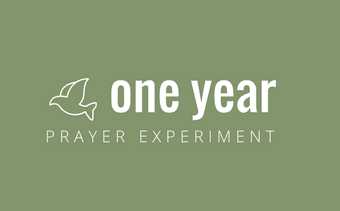This is the one year prayer experiment.
At the beginning, I wanted to see what would happen if I set aside thirty minutes every day, and took that time to pray. We are now about three months in, one quarter of the way.
What I have learned or gained so far?
A More Tangible Sense of God’s Presence
A sense of the presence of God is such a subjective, intangible thing. Many Christians fear such discussions. We tend to prefer a God we can neatly define and categorize. A God whose works we can neatly label. But when we start to talk about feeling God’s presence or God’s speaking to people, we quickly grow uncomfortable.

I would often include myself in that category. Determining the authenticity of such experiences is vital, and requires much discernment. To simplify things, the church in large part has dismissed such experiences. Years ago, reading medieval mystics forced me to wrestle with the reality of a tangible sense of God. Mystics like Bernard of Clairvaux or St Theresa of Avila would describe ecstatic experiences of God. St Theresa wrote of the time when God’s presence was so real to her, and the joy so great, that she wept for hours. My Western, logic driven mind struggled to comprehend such an experience.
But such experiences are real. I read the mystics’ experience. I personally know Godly people who find great comfort in God’s presence. And, as a new believer in junior high, I will admit I had a sense of the presence of God. But with time, the ups and downs of life, and the sinking deeper into Christian culture – that feeling faded.
That has changed recently. In the last few weeks, as I pray, I have started to become aware of God’s presence in a very real way. Like Darth Vader on the Death Star when Ben Kenobi shows up, “I sense a presence . . .”
I know in my head, theologically, that God is omnipresent. Psalm 139:7-10 clearly teaches that God is everywhere all the time when it says, “’Where shall I go from your Spirit? Or where shall I flee from your presence? If I ascend to heaven, you are there! If I make my bed in Sheol, you are there! If I take the wings of the morning and dwell in the uttermost parts of the sea, even there your hand shall lead me, and your right hand shall hold me.” (ESV)
So to be clear, my prayer did not cause an absent God to return to my location. What happened is that my consistent prayer has made my heart sensitive to his presence.
I won’t mince words, this sense of God’s presence is pretty awesome. As mentioned before, new-Christian me had a sense of God’s presence. Over time, and life, that sense faded. One of the things I had hoped to gain from this prayer experiment was a renewed sense of God’s presence. And with a twinge of joy in my heart I am glad to report that it has returned. Not that I like to agree with dastardly villains, but I am right there with Darth Vader when he finishes his sentence, “I sense a presence that I have not felt in a long time.”
More Tools In the Prayer Toolbox
 Going through this year long experiment, new tools are constantly being placed in my prayer tool box. I have discovered forms of prayer that are new to me. Forms of prayer that have existed for many, many years – but I am only now learning about. Forms of prayer like lament. I am also greatly deepening my understanding of more familiar forms of prayer – like praise.
Going through this year long experiment, new tools are constantly being placed in my prayer tool box. I have discovered forms of prayer that are new to me. Forms of prayer that have existed for many, many years – but I am only now learning about. Forms of prayer like lament. I am also greatly deepening my understanding of more familiar forms of prayer – like praise.
Thanks to this experiment, my prayer tool box has both new tools, and old tools that have been sharpened and tuned.
More Tools = More Flexibility
Before starting this experiment, I had one way to pray. It was an outline taught to me years ago when I was a young Christian. This outline is solid. It is simple to use, easy to remember, and keeps prayer reasonably balanced.
But it was the only way I knew how to pray. When life’s troubles were about to overwhelm me, I sat down and prayed my outline. Learning new facts about God’s character from studying the Bible, joy welling up inside, I prayed my familiar outline. God times or bad times, I had one basic way to pray. 
In our relationships with others, we intuitively know that different circumstances require different ways of communicating. The way a manager will talk to an under-performing employee will differ from the way a preschool teacher will talk to his student. The way my college football coach talked to me on the field greatly differed from how my mother spoke to me as a child. It makes sense that different moments require different approaches.
Yet our prayer lives are often founded upon a single form of prayer – like mine has been. By adding new forms of prayer to my experience, by adding new tools to the prayer tool box, I can now approach my conversations with God the same way most of us approach our conversations with others. I use an outline for most of my times in prayer, the one we learned about it in our post on How to Pray, but there are times when just slogging through an outline is not the way to talk to God. Let me give you a recent example from my own life.
 A few weeks ago, I experienced a serious set back at work. Bad enough to bring into question the continued survival of my business. Sitting down to pray the next day, with so much pent up frustration and emotion, working through an outline was not going to happen. Instead of stuffing the emotion and praying the outline, or skipping prayer altogether that day (and embracing the ensuing guilt), I realized this was the perfect opportunity to lament. I spent the majority of my prayer time lamenting my situation, asking God to rescue, and praising him. Praying a prayer of lament in that moment really set my heart right.
A few weeks ago, I experienced a serious set back at work. Bad enough to bring into question the continued survival of my business. Sitting down to pray the next day, with so much pent up frustration and emotion, working through an outline was not going to happen. Instead of stuffing the emotion and praying the outline, or skipping prayer altogether that day (and embracing the ensuing guilt), I realized this was the perfect opportunity to lament. I spent the majority of my prayer time lamenting my situation, asking God to rescue, and praising him. Praying a prayer of lament in that moment really set my heart right.
The next day, I was still a little bothered by my situation, but I did not want to dwell on the problems. I decided a “praise binge” was in order. One of my experiments was to only praise God for my entire prayer time. This day was a great day to do that. I just wanted to remind myself, and celebrate, how amazing God is. So, I opened up a Psalm and prayed through it. It was super encouraging. It was just what I needed.
On the third day, with fear and hurt no longer swirling around inside of me, I was ready to return to my usual prayer habits. I returned to my regular methods of daily prayer and settled back into my usual outline for regular prayer.
As we can see, it was great for me to have the tools of lament and of praise in my tool box. Situations arose where certain forms of prayer where more fitting than others. Knowing about these forms of prayer allowed me to use them – and have the right kind of conversation at the right time.
More Tools = More Authentic
These newfound tools have also made my prayer life feel more authentic.
Every single one of us has endured a shallow, fake relationship. A relationship where people act like they know and care for each other, but the reality is that the relationship is shallow. Words are exchanged, but no meaningful communication is occurring. No one is known, and no one is being known.

These relationships live everywhere. With our barista at the coffee shop, or with our coworkers. Sometimes even at home. I will even admit to them being rather common at the churches many of us attend.
The sad reality is that for many of us, our prayer life is the same way. When we sit quietly before God, we are not interested in being honest with him, we are interested in impressing him.
When times are tough, we fell the need to impress God with our strength, or our faith. “Everything is fine,” they tell God. We put on our stiff upper lip. At other times, we want to make requests to God, but instead of asking for what we actually want, we ask for what we feel we should want. Or we ask him for what we think he will give us, since, “He would never actually give me what I wanted.”
Our time in prayer, for many of us, is our time to impress.
It should not be that way. And putting more tools in my prayer tool box makes it easier for me to be authentic with God. When I hurt, I lament. When I am happy at seeing God’s hand at work, I praise him. After recognizing his work in my life, I offer thanksgiving. New tools make it easier to be real with God.



Recent Comments